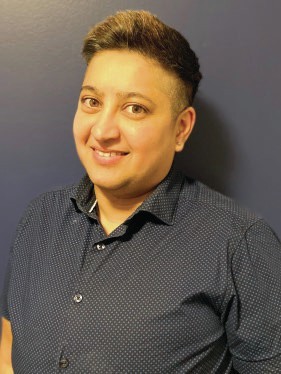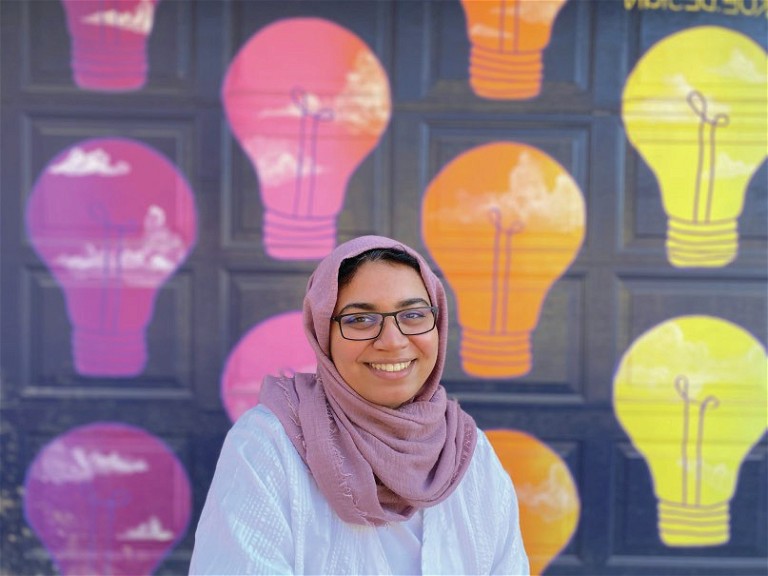Youth Helping Youth
COVID isn’t slowing Ontario’s LGBT YouthLine

LGBT YouthLine Executive Director Berkha Gupta,

Communications Coordinator Saadia Khan,
Back in 2010, author Dan Savage, who writes the sex-advice column “Savage Love,” launched a dynamic campaign with his partner Terry Miller called It Gets Better to offer hope to young LGBTQ2+ people struggling to make their way in the world. Whereas it does “get better” for many, there is always a new generation of young people needing affirmation and support.
In Ontario, LGBTQ2+ youth today have a place to turn to when they’re feeling isolated, discouraged, anxious or threatened: the Lesbian Gay Bi Trans YouthLine.
Statistics compiled by the Canadian Mental Health Association show that LGBTQ youth and trans people face increased risk of mental-health challenges. For example, they report that “LGBTQ youth face approximately 14 times the risk of suicide and substance abuse than heterosexual peers; 77% of trans respondents in an Ontario-based survey had seriously considered suicide, and 45% had attempted suicide.”
Launched in May 1994 to address the need for community-specific support, LGBT YouthLine started as a toll-free phone line for lesbian, gay, bisexual, queer and questioning young people across Ontario. It was soon supporting more than 400 LGBTQ2+ young people per month.
YouthLine has evolved over time, adding layers of support services over the years. Today they include live online chat, text support, a resources database – especially useful for youth in rural and suburban areas – and YouthOrganize, an online platform for LGBTQ2+ youth organizers introduced in 2019.
“YouthLine is really all about affirming and celebrating youth of all genders and sexualities,” says LGBT YouthLine Communications Coordinator Saadia Khan. “That is heavily aligned with my values of anti-racism, anti-oppression, Indigenous solidarity and of course the youth-centred aspect of it all: we are in an organization that is majority youth. All the volunteers are under 29, and the majority of staff as well. Because of that, our organization is pretty unique.”
TD READY COMMITMENT
TD is a long-time supporter of the Lesbian Gay Bi Trans YouthLine. Through the TD Ready Commitment, the Bank’s corporate citizenship strategy to help open doors to a more inclusive and sustainable tomorrow, TD is targeting $1 billion by 2030 to help create the conditions so everyone, including members of the LGBTQ2+ community, has the chance to succeed in a changing world. These efforts support change and nurture progress for members of the LGBTQ2+ community and beyond.
“We need to support our LGBTQ2+ youth, especially now when the issues they face have been intensified and access to supports has been more challenging due to the ongoing impacts of the pandemic,” says Amy Hanen, Associate Vice President – Social Impact (Canada), TD Bank Group. “We’re proud to continue working with YouthLine to help connect LGBTQ2+ youth with resources they need to ensure youth of all sexual orientations and gender identities are supported, and celebrated.”
“TD has been a long-time supporter and one of the largest supporters of our HelpLine,” says Berkha Gupta, Executive Director of the Lesbian Gay Bi Trans YouthLine. “Their continued commitment has supported our 2SLGBTQ+ youth volunteer training and supports. In the last few years, their growth in support has also meant that we can increase resources to better support the HelpLine.”
Support from TD builds on the Bank’s long-standing commitment to the LGBTQ2+ community that spans decades. It was the first bank in Canada to introduce same-sex spousal benefits in 1994 and announced it would add gender affirmation surgery benefits to support employees and their families in 2008. TD remains committed to helping drive progress forward for the LGBTQ2+ community.
VOLUNTEER EDUCATION
LGBT YouthLine provides an intensive program of training to its volunteers, says Peer Support Program Coordinator Ayan Ali. It includes “a lot of skills-development, meaning how to communicate boundaries, share insights, have a nonjudgmental view of other people, learning how to trust people. It’s all done by community members; it’s more of a lateral structure, as opposed to top-down.”
“Tier 1” training prepares volunteers for chat and text interactions with three hours of weekly instruction for 13 weeks. It includes peer-support training and the foundations for anti-oppression education, says Ali. “Topics like exploring what gender diversity looks like, how different communities might have different names, white supremacy, colonialism, ablism, community care: all of this is tied together with extensive scenario work.”
For instance, “if we’re talking about harm reduction, we might give them a scenario where someone is struggling with selfharm, and they are going to practise talking with that person.”
The next step is three weeks of shadowing, where volunteers work closely with shift supervisors. To qualify to work on the phone lines, they receive an additional five weeks of training. Ali describes this as “less factual-based” and more focused on “setting boundaries on the phone call, risk assessment, safety planning. We cover all these topics, and then they have a week of scenarios and two weeks of shadowing.”
PANDEMIC WINS
The COVID-19 pandemic hit an already struggling community hard, closing access to numerous resources like community centres and libraries, reducing safe spaces for youth facing abuse or inadequate housing, and even – very briefly – shutting down YouthLine. But pandemic adjustments have actually broadened the organization’s ability to serve isolated youth.
“A lot of the issues that LGBTQ+ youth have always dealt with are exacerbated by the conditions of the pandemic and by being a minor who may often be financially constrained in the context of a family that may be less than supportive,” Ali says.
However, “as much as the pandemic has made things really difficult, it also has accelerated our provincial mandate,” adds Khan. “A couple of years ago, YouthLine developed a new strategic plan. Part of that was to break out of the GTA and do more in northern and rural communities, and to have volunteers from all over the province. What the pandemic really did was force us to reimagine our volunteer structure. Now we’re able to have youth from all over the province join us.”
Thus, today, says Ali, “we have volunteers in remote, rural areas and in the north able to bring so much nuance and clarity to the issues that our clients are dealing with. I also want to touch on the fact that the youth that reach out to us are underresourced, but some of the savviest, most empathetic and resourceful people I’ve had a chance to meet, especially our volunteers. They are keen, constantly excited. They have so much value to offer to the YouthLine and to the LGBTQ+ community more broadly. There’s a lot of raw talent and ideas and willingness to collaborate if the opportunities and structure were there.”
With this influx of youth talent, “we have fully moved remotely in terms of the HelpLine service,” Ali says. “In the last few years, we’ve made considerable strides in unimaginable ways.”


